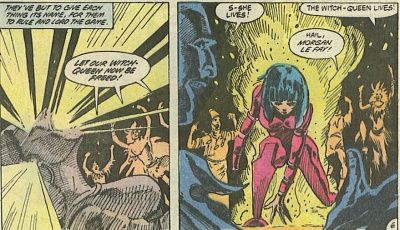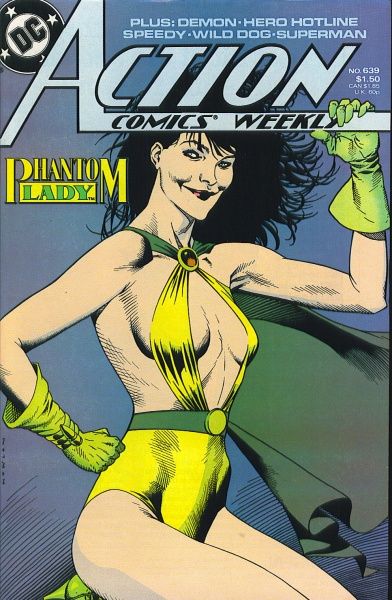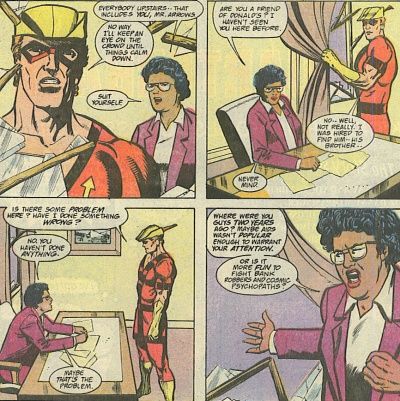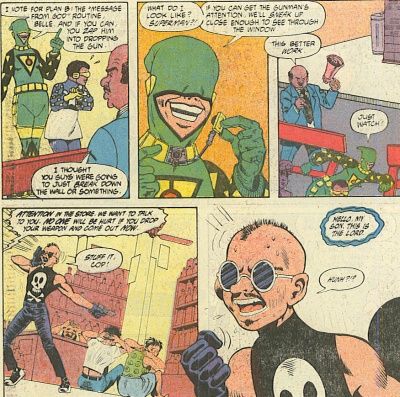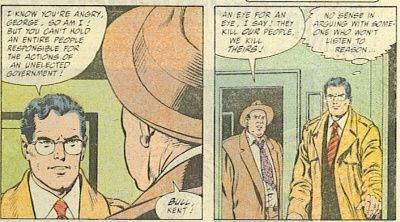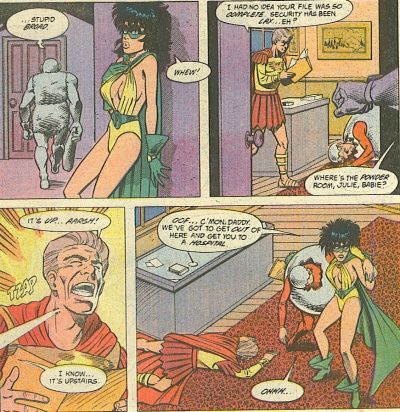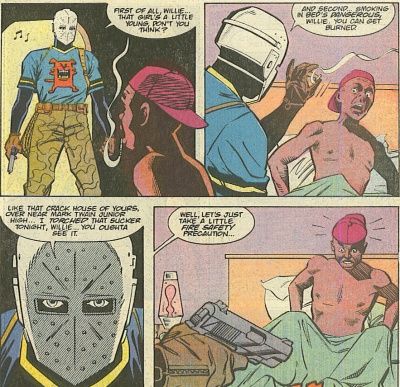As always, here are the rules to these posts.
After a week off, we return with ... an anthology series. Oh dear. In theory, I like anthologies. Occasionally, in practice they're a bit tough to pull off. Which will this be?!?!?
Action Comics Weekly #639. Published by DC, 21 February 1989.
First off, that's a great cover. Phantom Lady's body is attractive without being ridiculously buxom, and although nothing will ever make that a good costume, it's still a beautiful drawing. She looks like an actual woman. (Of course, this isn't the "original" Phantom Lady, so maybe they felt they could tone down the bosoms a bit, and yes, that hip bone is a bit weird.) Why didn't Kevin Nowlan ever become a bigger star?
Action Comics, for those who don't know, ended as a strictly Superman comic with issue #600 and went to an anthology format until issue #642. This format, while bold, failed spectacularly, and DC went back to Superman exclusively. The problem with this comic book, like a lot of anthologies, is that the stories in it aren't complete stories, and because they are so short, it's tough to become that invested in them. So a first-time comic book reader might enjoy the idea of picking up an anthology, but this doesn't really give them much of a reason to come back. Although there's some decent talent on the book (Mark Verheiden, Alan Grant, Roger Stern, Curt Swan, Max Collins and Terry Beatty), none of them are given enough room to make much of an impression. And because all of the stories are continued, if you don't like this comic, you probably won't be back.
Let's check out each story in order. Verheiden, with penciller Louis Williams and inker Frank McLaughlin, bring us a 7-page Speedy story. We get no indication why Speedy dresses up in a ridiculous costume, although we do learn that his gimmick is archery, even though he never uses his bow. So Speedy is a superhero, but this is decidedly not a superhero story, so it's a bit weird. Speedy has been hired to find someone, and we learn that the guy is dying of AIDS and that his brother is a famous action movie star (think Rambo). The actor, Sean Bauman, is angry because his brother's gay, and he's going to take it out on Speedy. Of course, our hero gets out of that pretty quickly, goes to the guy who hired him, and quits. He didn't know that the guy he was hired to find - Donald Lossner - was Bauman's brother, and then it turns out he doesn't know where Lossner is anyway. We find out he has an infant daughter before he goes on a date with legal secretary he met at a "crime scene," which presumably happened in an earlier issue. She finds out he has a daughter and we're pretty sure she's going to dump Roy (as we learn is his name), but he spots Lossner on the news in the bar and tells her he has to leave. We'll never know if she dumps him or not! Speedy heads to an AIDS clinic, which is under siege, and the resident physician makes him feel guilty for fighting bad guys instead of worrying about AIDS for years. The doctor says, "Could it be you were scared - like everyone else?" Speedy looks sufficiently guilty. The story is continued next issue!
Next we get a 7-page Demon story. Thankfully, it features the Demon in only one (wordless) panel, so we're spared the awful poetry that every writer feels the need to write for Etrigan. A woman named Glenda and a blind man named Randu are using a philosophers' stone (the philosophers' stone?) to ... well, do something. Glenda sees a woman in a place called Wookey Hole, and she and Randu decide to visit it, as it is near Tintagel, where "Jason" is. We learn that a demon, Asteroth, is luring them to the spot, as he helpfully explicates to his prisoner, Merlin. We don't learn what Asteroth is up to, however. That's for another day! At Tintagel, a man (whose name we never learn, but we can assume it's Jason) checks out a statue, which happens to be Morgan le Fay turned to stone. We also learn that he is the "cage" of Etrigan, put there by Merlinas a last resort when Morgan captured the castle "more than a thousand years ago." Glenda and Randu, meanwhile, enterWookeyHole,"one of the largest unexplored cave systems in the world," andpoke around, until Glenda uses the stone and feels it tugging her into a fissure in the rock. The scene abruptly shifts to the outside at night, where a group of witches perform a ceremony to change Morgan back from stone. They succeed, but she kills them all because shelost a hand in battle when she was turned to stone and isn't too happy about it. As she's killing them, we see Etrigan perched high above her, smiling. What does that portend? We don't know, because it's continued next issue!
Moving on, we find a very odd story about the Hero Hotline, written by Bob Rozakis, drawn by Stephen de Stefano, and inked by Kurt Schaffenberger. The style is very reminiscent of 1940s comic strips, with exaggerated human forms, beads of sweat flying from foreheads, goofy costumes, and outrageous heroes. Yet is also features a cleaver-wielding crazy person and a hostage-taker who commits suicide. In seven pages, Rozakis finishes one story, tells another, and starts a third, to be continued next issue. We get a good sense of what the heroes can do, butbeyond the fact that this is apparently some service where people can call up and request a hero, we have no idea what's going on. Are these recurring characters? Does each story feature an entirely new hero? Is this some kind of job and they get paid? It's weird. Plus, as each story is so short, we don't get much other than a very simple plot. The guy who takes the hostage and then commits suicide out of guilt (the hero Voice-Over convinces him that God is watching him, and he doesn't want to face his crimes) demands a bit more than 3 pages, but that's all he gets! This is an idea that could, conceivably, work, but not in the space allotted, and not with Rozakis trying to jam so much into that space.
In the center of the book is the two-page Superman story that apparently ran through every issue of the weekly anthology, this time written by Stern, pencilled by Swan, and inked by Murphy Anderson. A suicide bomber has killed 16 somewhere, and Qurac is claiming credit. An angry guy at the Daily Planet thinks Superman should "pull the legs off every last Quraci," but mild-mannered Clark Kent tells him that he "can't hold an entire people responsible for the actions of an unelected government." Meanwhile, at a restaurant run by a Quraci immigrant, two wholesome American lads beat up the proprietor and set the place on fire. Thus endeth the story! Swan's art is solid as usual, and although Stern doesn't get much room, he makes the space count. It's not all that great a two-page story, but at least we understand what's going on and it has a decent cliffhanger. And, of course, there's the whole prescient angle it has. Qurac was always fun. It's interesting that a first-time comic book reader would have no problem getting into this story, with the possible exception of the fact that they might not know Clark Kent is Superman. Of course, if they don't know that, they probably need to turn in their passport and move to Chad, because they aren't real Americans!
The Phantom Lady story is next, and it's notable not because it was written by Len Strazewski or inked by Gary Martin, but because it's drawn by Chuck Austen! Yes, Chuck Austen, destroyer of good books everywhere! If you've never seen Austen's art, you're probably lucky, because it's stiff and awkward looking and actually helped lessen the greatness that is Alan Moore's Miracleman in the middle chapters. Anyway, the Phantom Lady in this story is named Dee, and she goes to a ball at somebody named Guerreheart's mansion. It has something to do with Les Mille Yeux, a "major international crime cartel," and her father, who is somehow being blackmailed. At the party, she eavesdrops on her father and Guerreheart. Her father has given over what the bad guy wants, but Guerreheart decides to keep blackmailing him. Her father attempts to take back what's his by brandishing a gun, but Guerreheart's flunkie whacks him with a club. Phantom Lady comes in, disables Guerreheart, and flees with her unconscious father. She tells her boyfriend that she's coming back to the mansion, because now she knows what she's looking for and where to find it. Needless to say, it's to be continued!
The final story is a Wild Dog tale by Collins and Beatty, with John Nyberg inking. Wild Dog (who's obviously some hardcore vigilante - he wears a hockey mask, for crying out loud!)burns a crack house to find its owner. He arrives at the owner's apartment, puts Michael Jackson's Bad CD in the player (would I lie?), and proceeds to start drowning him in his shot-up waterbed in order to find out his connections. The dealer finally tells him that he'll show our vigilante where to find the Jamaicans from whom he gets his drugs. Something tells me there will be a great deal of slaughter ... next issue!
As you can tell, there's a lot going on in each issue of Action Comics Weekly, but if this issue is any indication, there's not many good reasons to return to an issue. If you're a first-time comic book reader, anthologies could be a good gateway into other comics, but they need a few things: top-notch talent, at least on one story, and in this, the best talent is probably Stern and Swan, but their story is only two pages long; complete stories, again at least one, but none in this issue are complete, except for the brief one in the middle of the Hero Hotline story; recognizable and easily digested characters, and except for Superman, we don't really get one here. We don't know or discover much about Speedy, Etrigan, the heroes of Hero Hotline, Phantom Lady, or Wild Dog. I realize that the space constraints mean we really can't learn much about them, but if you're lacking the first two criteria for a solid anthology, the third might help. The most recent anthology I have bought is, I think, Western Tales of Terror, and that had complete stories and some very good creators. It wasn't a great comic, but it was a satisfying one. This issue, despite continuing the following week and therefore cutting down on the time a reader needs to wait for resolutions, doesn't do a very good job at getting people to come back. There are six different stories in this comic, and except for the two-page Superman story, they're all seven pages. Perhaps cutting one or two and lengthening the others would have helped. Perhaps.
For a first-time comic book reader, there's not a lot to draw us back to the comic or other comics in general. I don't doubt that the stories within the comic, and not the format itself, led to its change back to a monthly starring Superman. It's nice to get a bunch of pages and characters for $1.50, but at some point the reader needs something good. All anthologies are going to be hit-or-miss, but this is almost all miss. A nice experiment by DC, but it's not surprising, based on this issue, that it failed.

